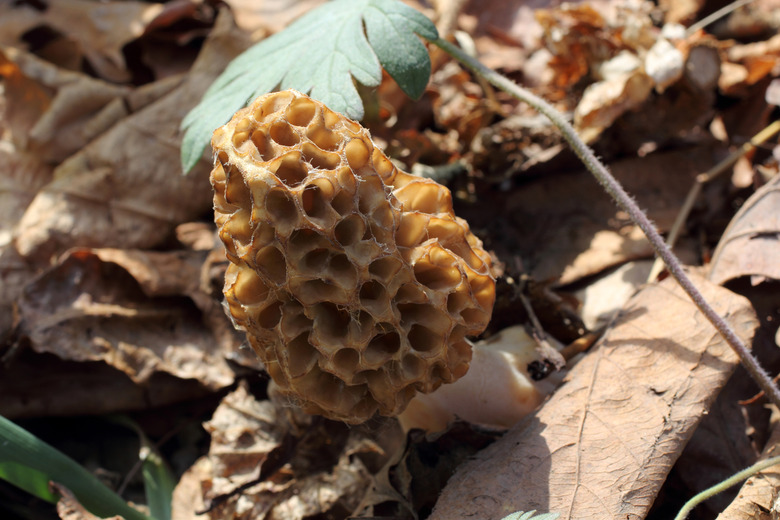Edible Wild Mushrooms In Illinois
Mushroom hunters discover a variety of delectable fungi throughout much of the year in Illinois. Puffballs, portobellos and morels are among the wild mushrooms growing seasonally in the state. Knowing when each edible species emerges determines when to look for them.
Early Arrivals
Early Arrivals
Yellow, black and half-free varieties of morels can be found in wooded areas in Illinois in late March and all of April. Their sponge-like caps make them easy to spot and identify. Many Illinoisans flock to the woods to find these edible mushrooms, and some communities even celebrate their arrival with events such as the Annual Illinois State Morel Mushroom Hunting Championship and Spongy Fungi Festival. As the morel season dies down in Illinois in May, the golden yellow chicken mushrooms begin to crop out of infected logs or trees with a growing season lasting until Halloween or even Thanksgiving.
Mid-season Varieties
Mid-season Varieties
Puffballs mature in Illinois in late summer to mid-fall and are best when they are white with spongy interiors. Puffballs are commonly found around the outside of fairy rings, which are circles of grass that grow faster and darker green, denoting the fruit of fairy ring fungi. Coral fungi appear in wooded areas of Illinois in either summer or fall on decaying logs or on the ground. Coral fungi – also called club, doghair or antler – resemble clumps of sea coral growing up to 8 inches high. Most are yellow, white or tan although a few are purple or pink. Coral fungi appear in wooded areas of Illinois in either summer or fall on decaying logs or on the ground. Another delectable fungus in Illinois is the parasol mushroom, which sports a recognizable bump on top of its cap. The reddish scales on the stem and a loose collar also help identify this mushroom.
Later Season Mushrooms
Later Season Mushrooms
Hen of the woods, maitake, ramshead or sheepshead often weigh 20 lbs. or more per specimen and thrive in areas containing many large oak trees. Although usually found in fall, they have been found in both summer and spring. When exposed to direct sunlight in open spaces, the upper surface is brown, tan or gray – never reddish or orange – with white undersides. Meadow mushrooms, champignon or "champion" as the locals call it, with their white kid-skin caps and pale pink gills can be found on golf courses and pastures in Cook County in good fall weather. Another mushroom closely resembling the meadow mushroom is a species of mushroom local hunters in southern Illinois refer to as the "wild portobello" or the brown meadow mushroom.
Multiple Season Fungi
Multiple Season Fungi
The honey mushroom, one of the stump fungi, grows at the base of deciduous trees, on old wood or stumps, and sometimes on live shrubs or trees. The oval, yellow or rust-colored cap can grow to 4 inches across, resting on a 6-inch stalk. The cap can feel either sticky or dry. Gills underneath the cap of a young honey mushroom appear white then turn yellow and eventually reddish as the fungi ages. Since the main bodies of these mushrooms spread underground for miles, they are the world's largest and oldest organisms. Some are over 400 years old. Shaggy mane or lawyer's wig, the largest member of the inky cap mushrooms, grows 4- to 6-inches tall with a cap – a long, white cylinder with brownish upturned scales – and white gills. Shaggy main grows during spring, summer and fall in pastures and lawns in soil, grass or wood chips.
A Word of Caution
A Word of Caution
Many edible mushroom varieties have look-alike cousins that can cause serious illness or worse to people who attempt to eat them. For example, the destroying angel – which may be confused with parasol or honey mushrooms – have enough toxins to kill a person. Other non-edible mushrooms can induce less severe reactions but must be avoided. If uncertain whether a mushroom is edible, throw it out. Always make a positive identification, even asking an experienced mushroom hunter, before eating or cooking wild mushrooms.
References
- American Mushrooms: The Yellow Morel
- Illinois State Morel Mushroom Hunting Championship: Information
- NetState.com: The State of Illinois
- University of Illinois Extension: Fairy Rings, Mushrooms and Puffballs
- American Mushrooms: Hen of the Woods
- Forest Preserve District of Cook County (Illinois): Edible Mushrooms
Cite This Article
MLA
Yirka, Tonya. "Edible Wild Mushrooms In Illinois" sciencing.com, https://www.sciencing.com/edible-wild-mushrooms-illinois-8391806/. 13 March 2018.
APA
Yirka, Tonya. (2018, March 13). Edible Wild Mushrooms In Illinois. sciencing.com. Retrieved from https://www.sciencing.com/edible-wild-mushrooms-illinois-8391806/
Chicago
Yirka, Tonya. Edible Wild Mushrooms In Illinois last modified March 24, 2022. https://www.sciencing.com/edible-wild-mushrooms-illinois-8391806/
